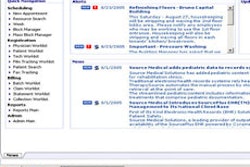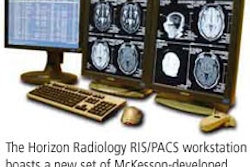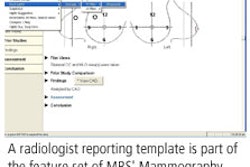SAN DIEGO - A multifacility independent delivery network (IDN) in Santa Barbara, CA, has begun rolling out an electronic health record (EHR) that integrates more than 130 information technology (IT) applications, developed by various vendors, in its enterprise. Rather than attempting to forklift a monolithic, one-size-fits-all EHR onto the institution, the IDN chose to integrate its existing clinical systems and databases.
"We are a best-of-breed environment that has been highly aggressive in its deployment of clinical applications," said Alberto Kywi, chief information officer for Cottage Health Systems of Santa Barbara.
Kywi discussed the challenges and architecture of creating a context-sensitive EHR at his institution on Monday morning at the Healthcare Information and Management Systems Society (HIMSS) conference.
According to Kywi, the three-hospital, 602-bed Cottage Health System supports more than 1,500 workstations with a 25 full-time equivalent (FTE) information systems (IS) staff. The group doesn't have an in-house software-development team, so it utilizes outsourced project management professionals for specific tasks.
The EHR initiative at the institution has three strategic elements, Kywi said. The EHR has to suit Cottage Health System's multientity environment, teaching hospital needs; it has to provide universal access, including remote access, to patient information; and it has to emphasize using IT to promote patient safety initiatives.
"Early on in the process we came to the conclusion that no single system or vendor can do it all," he said.
In addition, the facility did not want to abandon a considerable investment in time and resources that had been devoted to the successful implementation and integration of department-based clinical systems. Cottage Health had installed a clinical information management system (CIMS) that provided universal access to documents and results eight years ago, and had a long history with fully filmless RIS/PACS (DR Systems, San Diego).
Recent IT initiatives at the institution included a physician portal from Healthvision of Irving, TX; an electronic signature application for transcribed reports from FutureNet Technologies of Monrovia, CA; a computerized physician order entry (CPOE) system from healthcare informatics firm Eclipsys of Boca Raton, FL; an emergency department documentation product from Picis of Wakefield, MA; a fetal monitoring system from Phillips Medical Systems of Andover, MA; a pharmacy automation system from McKesson Provider Technologies of San Francisco; and single sign-on and context sharing applications developed by security applications vendor Sentillion of Andover, MA.
The most commonly used mature clinical applications were the RIS/PACS, electronic dictation, clinical documentation, and the physician portal, Kywi said. The addition of CPOE, fetal monitoring, and emergency department documentation systems raised the bar in the EHR integration challenge for Cottage Health.
"Our initiative was to integrate an EHR for multiple applications with multiple users that had diverse clinical workflows and diverse user interfaces," he said.
The IS team achieved one level of integration using an interface engine (Software Technologies, Monrovia, CA) and the HL7 standard. A second level of integration was achieved through standardizing the workstation environment.
"We have access to all applications from a common desktop," Kywi said.
A single sign-on feature enables access to all relevant applications in a prompt timeframe. For example, prior to the integrated desktop deployment, physicians could expect to a spend a little over two minutes to sign-on and access the RIS/PACS, CPOE, dictation viewer, and CIMS. With the integrated desktop and single sign-on application, access to all available systems takes slightly longer than 10 seconds, according to Kywi.
The use of emulation software and compliance with the clinical context object workgroup (CCOW) standard has enabled Kywi's group to launch a multitude of clinical system applications from a Microsoft Windows XP desktop. By utilizing CCOW, Kywi has been able to architect a schema that communicates authenticated user information to participating systems in a manner that does not require those systems to alter basic code or functionality.
The use of the standard has also provided the IDN the capability to enable a dynamic clinical desktop that displays clinical applications appropriate to an authenticated user's role in the healthcare system. For example, nurses will see different applications on their desktop than would referring physicians.
This capability has been deployed throughout Cottage Health, and the facility also utilizes the component to share user and patient context with two competing healthcare organizations in the area as part of the Santa Barbara County Care Data Exchange (CDE), a project that electronically shares patient-specific information between multiple healthcare institutions in the region.
Not only has sign-on and access to various commonly used clinical applications improved for physicians at the facility, but access to patient records has as well. According to Kywi, previously a query for a single patient's dictation records took 33 seconds, RIS/PACS took 27 seconds, CIMS took 15 seconds, and CPOE took 17 seconds. With the integrated desktop, a query to any open clinical application will return that patient's records in all open clinical applications -- allowing the return of patient information from the RIS/PACS, CPOE, CIMS, and electronic dictation in about 10 seconds.
Kwyi said that the facility is not necessarily looking for strictly a monetary return on investment for its EHR capabilities.
"We're looking for outcomes on the basis of specific objectives," he said. "These include a measurable increase in patient safety, cost-effective patient care in terms of efficiency and workflow, better system acceptance and utilization, and a higher rate of compliance with our policies and regulations."
By Jonathan S. Batchelor
AuntMinnie.com staff writer
February 14, 2006
Related Reading
Eclipsys upgrades Cottage Health, September 27, 2005
DR Systems takes part in Care Data Exchange, February 10, 2005
A road map for integrating FFDM with generalized PACS, December 14, 2004
Referring physicians give thumbs up to PACS, June 11, 2002
Survey finds switch to PACS is well received at California community hospital, November 29, 2000
Copyright © 2006 AuntMinnie.com



















